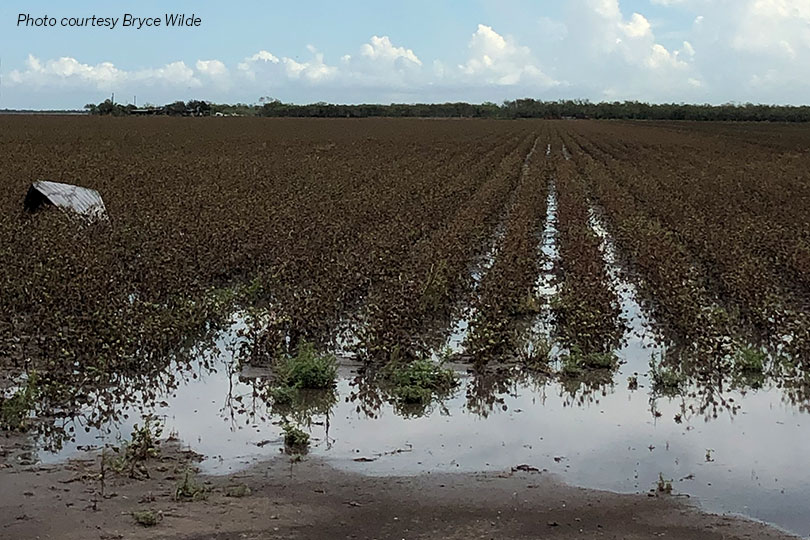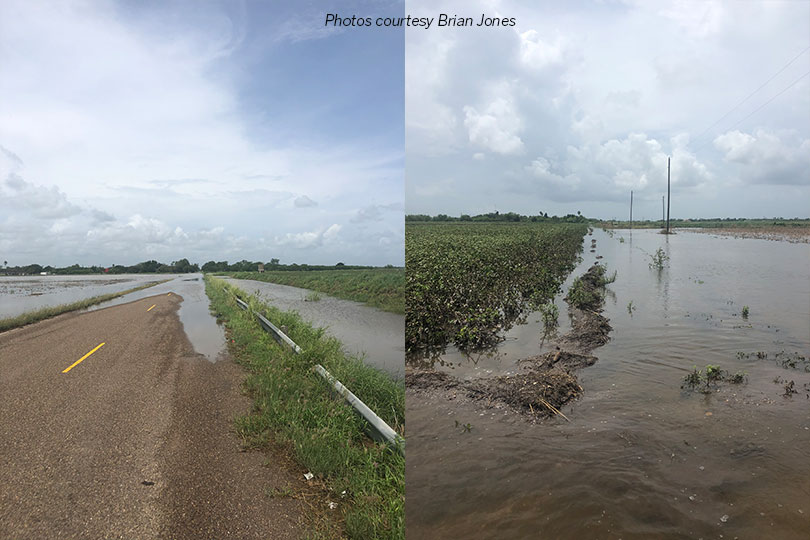By Jennifer Dorsett
Field Editor
In late July, tropical storm Hanna developed into a Category 1 hurricane, lashing the Texas Gulf Coast and the Rio Grande Valley with high winds and widespread rainfall.
The first hurricane of the 2020 Atlantic season first made landfall with 90 mile per hour winds (mph) in the Rio Grande Valley along the Cameron-Willacy county line. Preliminary reports suggest areas of the Rio Grande Valley and Coastal Bend received anywhere from 2 to 15 inches of rain.
In the largest citrus-growing area of Texas, orchards loaded with developing oranges and grapefruit are now standing in water, fruit bobbing uselessly underneath the trees.
Cotton is strung out of the bolls where it wasn’t blown away completely. Sesame plants are laid over, covered by a foot of dirty water.
It’s more bad news in an already troubled year for Rio Grande Valley farmers.
Willacy County

An unusually dry start to 2020 had many area farmers, even those with irrigation, cutting back on cotton acres.
“We had about 1,800 acres in the field when this hurricane hit, which was down quite a bit because of the drought,” Willacy County Farm Bureau (CFB) member Bryce Wilde told the TFB Radio Network.
Wilde and his family were able to harvest about 500 acres before the hurricane hit. He said yields were averaging from two to two-and-a-half bales per acre, a blessing after the tough start to the season.
But Hanna stripped the rest of his cotton clean. And what wasn’t blown away is underwater. He estimated his area received anywhere from 10-15 inches of rain.
Irrigation ditches are full to overflowing, and Wilde said it will likely take weeks for the water to recede.
“When you combine the high winds with this pooling water, I think that’s a one-two punch that pretty much sealed the deal on those crops,” he said.
Sugarcane, Wilde’s other major crop, fared better during Hurricane Hanna.
“Sugarcane can take a lot of water, but I’ve never seen a storm snap stalks like I saw it do this time around. Some of the early planted stuff that had six or seven months of growth time, those upper three or four nodes of sugar cane got snapped off, which isn’t a problem,” Wilde said. “It’ll all regrow, but we lost some yields there, for sure. But it can handle sitting in quite a bit of water for a while, so that’s okay.”
Cameron County

“This year was one of the most unique years I can remember,” Cameron CFB member Chris Sparks said. “We started out with hardly any rain. Then, we caught enough rain to make a little bit of a corn and grain crop, but the cotton was coming along pretty nicely. And then the hurricane hit. I’d say the RGV cotton crop is a complete loss.”
Sparks, a dryland cotton farmer, said he now has 800 acres of cotton under water with nowhere for the water to go. What cotton wasn’t blown out of the bolls by the high winds—which he noted a neighbor clocked at 100 mph—is going to have serious quality degradation where floodwaters are still standing.
“I have cotton that was ready to be picked that’s completely gone,” Sparks said. “What cotton I had that wasn’t quite ready to be picked will fare better, but it’s still damaged.”
He added many area farmers had cotton crops that never came up due to the drought, so they went planted sesame, which was also damaged by the hurricane.
“Their sesame is lying completely flat in the fields,” he said. “I don’t see how you can recover from that. We’ve had big rains in June back-to-back for the past two years, and now we’ve added a hurricane in late July this year. It’s been really hard on everybody.”
For now, all he can do is focus on the future.
“Trash is everywhere. Fences are down. A few buildings were down, and lots of people don’t have power,” Sparks said. “All we can do until the floodwaters recede is just try to get our houses back in order.”
Hidalgo County

Although further inland than Cameron or Willacy counties, Hidalgo County was also ravaged by Hurricane Hanna.
For many, the cotton crop appears to be a total loss, according to Hidalgo CFB member Brian Jones.
“I don’t know how much rain we had—at least 12 inches,” Jones said. “We’ve got cotton with 70 percent open bolls standing in one to two feet of water. A lot of cotton was strung out and blown out from the rain and the high winds, so we’re looking at probably a total devastation of the cotton crop down here.”
What concerns Jones is how close it is already to the state-mandated cotton stalk destruction date.
“Any cotton that was open and exposed to the storm is out of the boll. It’s not pickable. And we’re basically 35 days away from our plow-out date in the RGV,” he said. “We have to have our cotton stalks completely destroyed by Sept 1, so we’re looking at that date, as well. We’re right up against the plow-out date so really, the best result we could see is a zeroed-out cotton crop.”
Although it was a dry year, Jones, who irrigates his crops, said his cotton was in good shape before Hanna hit.
“It was already going to be a shorter year for the gins because there wasn’t as much cotton grown this year, but now it looks like there may not even be anything left to harvest,” Jones said. “Gins, trucking…all the related industries are going to be hurt by this.”
